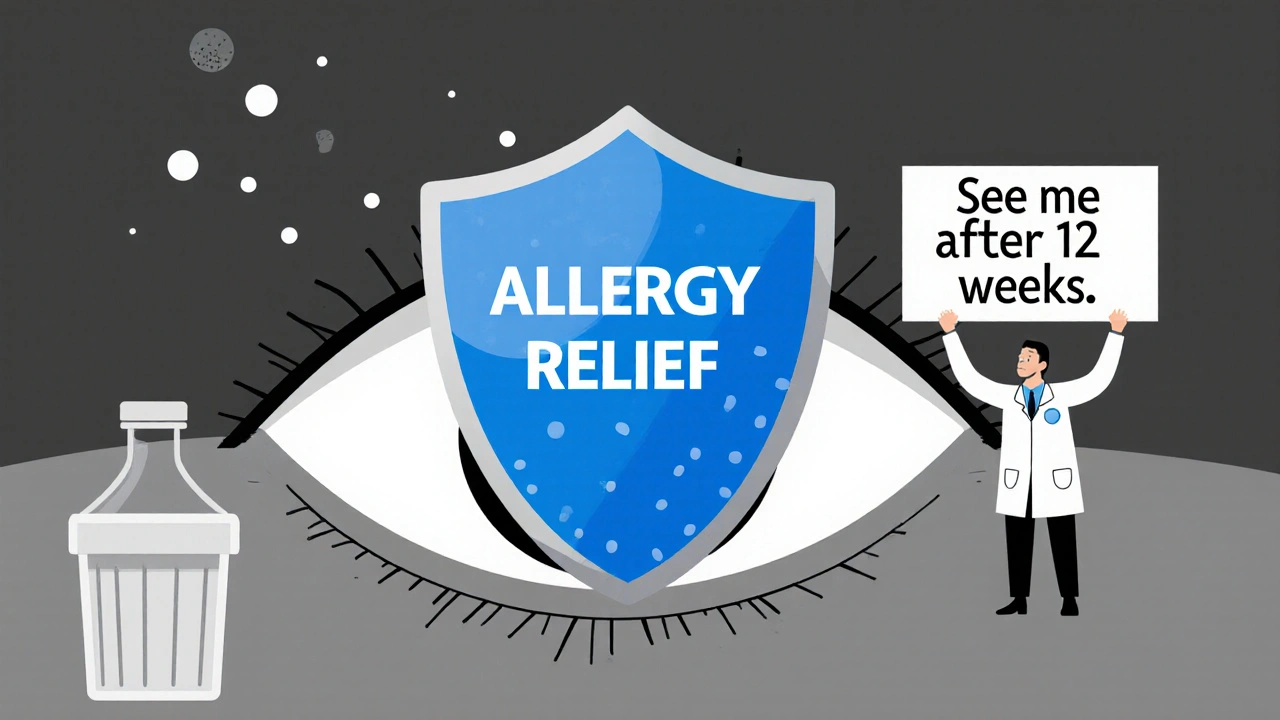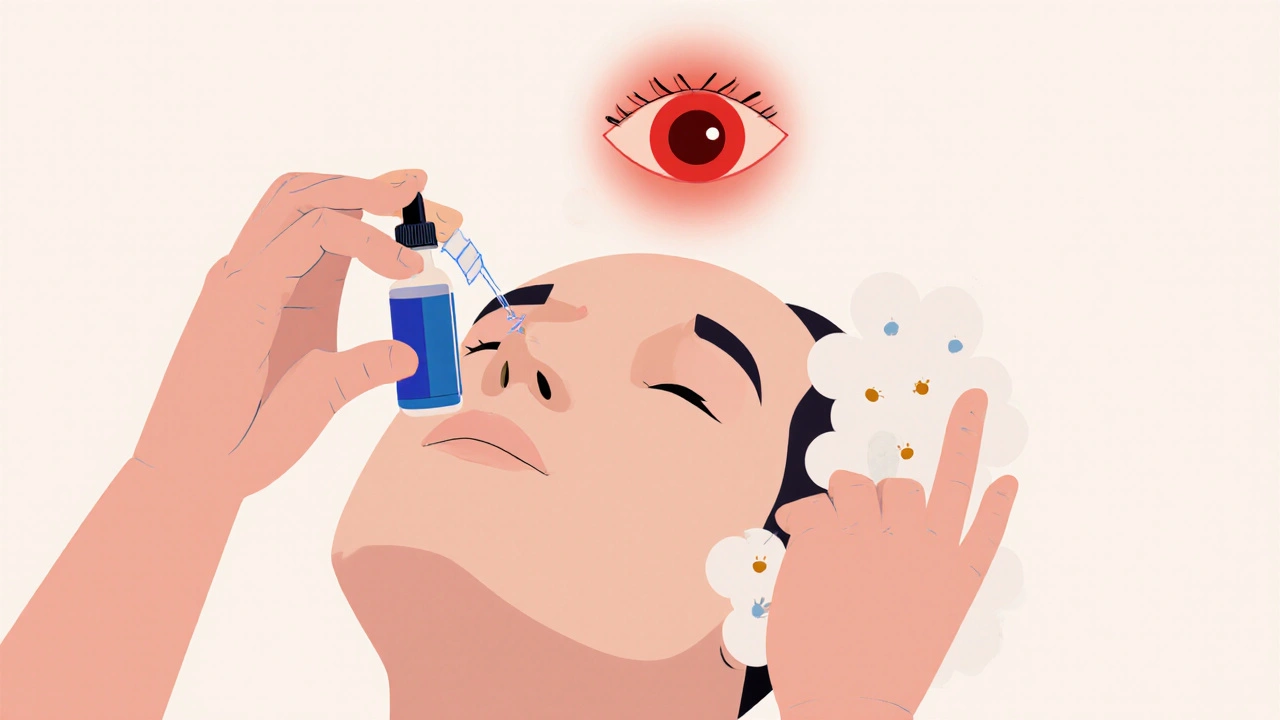Antihistamine Eye Drop Comparison Tool
Which Antihistamine Eye Drop Is Right for You?
Answer a few quick questions to find the best option for your allergy symptoms.
Recommended Antihistamine Eye Drops
Answer the questions above to see your personalized recommendation.
What Are Topical Antihistamine Eye Drops?
Topical antihistamine eye drops are designed to treat allergic conjunctivitis - the itchy, red, watery eyes caused by pollen, dust, pet dander, or other allergens. Unlike oral antihistamines that make you drowsy or dry out your mouth, these drops work right where the problem is: your eyes. They block histamine, the chemical your body releases during an allergic reaction, before it can trigger itching and swelling.
These aren’t new. The first ones, like levocabastine, hit the U.S. market in the early 1990s. Today, you can find them over-the-counter (OTC) or by prescription. Common brands include Ketotifen (Zaditor, Alaway), Olopatadine (Patanol, Pataday), and Azelastine (Optivar). Each has slightly different strengths, dosing, and side effects.
How Fast Do They Work?
If you’ve ever had eyes that feel like they’re on fire from pollen, you know speed matters. Most antihistamine eye drops start working in 3 to 15 minutes. Olopatadine 0.7% (Pataday Once Daily Relief) can reduce itching in under 3 minutes, according to clinical trials. Ketotifen usually takes a little longer - around 10 to 15 minutes - but still gives relief faster than waiting for an oral pill to kick in.
The duration varies too. Olopatadine 0.7% lasts up to 24 hours, so you only need one drop per day. Ketotifen and azelastine usually need to be used twice daily. That’s why many people prefer Pataday - fewer drops, less hassle. But if you only get allergies in spring, OTC ketotifen (like Alaway) is cheaper and just as effective for occasional use.
Side Effects: What to Expect
These drops are generally safe, but they’re not side effect-free. The most common complaint? A quick sting or burn when you first put them in. About 41% of new users report this, according to a 2022 study in Clinical Ophthalmology. It’s brief - usually gone in 30 seconds - but it can be startling.
Some people get redness or dryness after a few weeks of daily use. That’s often because of the preservative, benzalkonium chloride, found in multi-dose bottles. If you’re using drops every day for more than a month, consider switching to preservative-free single-use vials. Brands like Lastacaft (olopatadine 0.2%) offer this option.
Less common but more serious: increased eye pressure. This is rare, but it can happen if you use these drops for more than 12 to 16 weeks without checking in with an eye doctor. People with glaucoma or a family history of it should be especially careful. The FDA warns that prolonged use can mask worsening conditions - like bacterial infections or dry eye disease - that need different treatment.
Proper Use: Don’t Make These Mistakes
Using eye drops wrong can make them less effective - or even dangerous. Here’s how to do it right:
- Wash your hands before handling the bottle.
- Don’t let the dropper tip touch your eye, eyelid, or any surface. That’s how bacteria get in.
- Tilt your head back, pull down your lower lid, and drop one drop into the pocket. Close your eye gently for 30 seconds.
- If you’re using more than one type of drop, wait at least 5 minutes between them. Otherwise, the second one just washes out the first.
- If you wear contacts, wait 10 to 15 minutes after using drops before putting them back in. Some users report blurry vision or discomfort if they don’t wait.
- Throw away multi-dose bottles after 4 weeks, even if they’re not empty. Contamination risk rises sharply after that.
Many people don’t know this: refrigerating the drops can reduce the sting. Just don’t freeze them. A quick chill in the fridge makes the first use much more comfortable.
OTC vs. Prescription: Which One Should You Choose?
Here’s how the main options stack up:
| Brand/Active Ingredient | Strength | Dosing | Onset | Duration | Cost (OTC/Prescription) | Best For |
|---|---|---|---|---|---|---|
| Ketotifen (Alaway, Zaditor) | 0.025% | Twice daily | 10-15 min | 8-12 hours | $15-25 (OTC) | Occasional use, budget-friendly |
| Olopatadine (Patanol) | 0.1% | Twice daily | 3-5 min | 12 hours | $80-100 (Rx) | Daily allergy sufferers |
| Olopatadine (Pataday) | 0.7% | Once daily | 3 min | 24 hours | $85-120 (Rx) | Convenience, long-lasting relief |
| Azelastine (Optivar) | 0.05% | Twice daily | 3 min | 12 hours | $70-90 (Rx) | Fast relief, but bitter taste |
Ketotifen is the go-to for most people because it’s cheap, easy to find, and works well for seasonal allergies. But if you need daily relief, olopatadine 0.7% is the most effective long-term option. Azelastine works fast but leaves a bitter taste because it drains into your throat - not fun if you’re sensitive to that.
When Not to Use Them
These drops won’t fix everything. If your eyes are swollen, crusty, or producing yellow/green discharge, you likely have a bacterial infection - not allergies. Antihistamine drops won’t help. In fact, delaying proper treatment can lead to corneal damage. The FDA has documented dozens of cases where people kept using OTC drops for weeks while their infection got worse.
They also don’t work well for chronic dry eye unless it’s triggered by allergies. If your eyes feel gritty, tired, or burn all day long - even when pollen counts are low - you might need lubricating drops or other treatments.
And never use them if you’ve had eye surgery in the past 30 days, unless your doctor says it’s okay. Same goes for chemical burns or trauma. These drops aren’t for emergencies.
Real User Experiences
On Reddit, users share mixed stories. One person wrote: “Zaditor gives me 12 hours of relief, but the first drop feels like hot sand in my eye.” That initial sting is common. Another said: “I’ve used Alaway every day for three months. My eyes got redder, not better. My optometrist said I was masking a dry eye condition.”
On Drugs.com, 52% of users rate ketotifen as effective, but 68% report the burning sensation. Amazon reviews show similar trends - high satisfaction for quick relief, but complaints about irritation after long-term use.
Success stories exist too. A nurse with latex allergies used olopatadine 0.2% daily during surgery rotations and reported zero eye symptoms. But she also saw her doctor every 8 weeks to check for pressure changes.

When to See a Doctor
You don’t need to see a doctor for every itchy eye. But if any of these happen, it’s time to get checked:
- Redness or swelling gets worse after 3 days of using drops
- Your vision becomes blurry or distorted
- You feel pain, not just itchiness
- You’ve been using drops for more than 12 weeks
- You wear contacts and still have symptoms
Doctors can test for allergies, check your eye pressure, and rule out infections or autoimmune conditions. They can also recommend combination therapies - like adding a mast cell stabilizer or a short course of steroid drops - if your symptoms are severe.
What’s New in 2025?
Recent advances include new formulations with less preservative irritation and longer-lasting effects. In 2023, the FDA approved a nanoemulsion version of olopatadine that reduces stinging and lasts 16 hours. Clinical trials are also testing low-dose steroid combinations for severe cases like vernal keratoconjunctivitis - a condition that affects kids and young adults with extreme allergies.
But there’s a downside. Single-use vials create a lot of plastic waste. The American Academy of Ophthalmology estimates U.S. users throw away over 2 tons of plastic packaging every month from these drops. Some companies are exploring eco-friendly packaging, but it’s still early.
Final Thoughts
Topical antihistamine eye drops are one of the most effective, safest tools for managing allergic eye symptoms. They work fast, target the problem directly, and avoid the grogginess of pills. But they’re not magic. Misuse - especially long-term, unmonitored use - can cause more harm than good.
Use them as directed. Know your limits. And if your eyes don’t improve in a few days, or if they get worse, don’t guess. See an eye care professional. Your vision is worth more than a $20 bottle of drops.




Logan Romine
November 21, 2025 AT 03:10Daisy L
November 22, 2025 AT 00:31Corra Hathaway
November 22, 2025 AT 10:27Kartik Singhal
November 24, 2025 AT 03:16Noah Fitzsimmons
November 24, 2025 AT 13:05Chris Vere
November 25, 2025 AT 23:16Pravin Manani
November 26, 2025 AT 23:50Franck Emma
November 28, 2025 AT 04:15Anne Nylander
November 29, 2025 AT 04:07Leo Tamisch
November 30, 2025 AT 03:20Eliza Oakes
December 1, 2025 AT 12:33Clifford Temple
December 3, 2025 AT 01:08Mark Kahn
December 3, 2025 AT 11:08